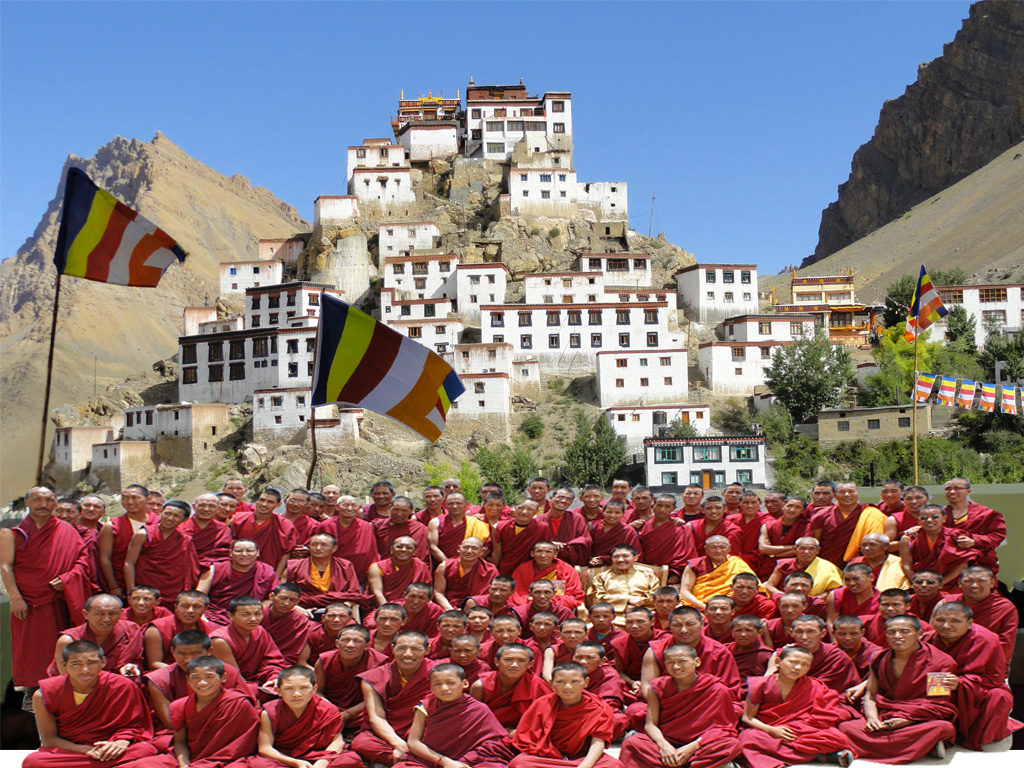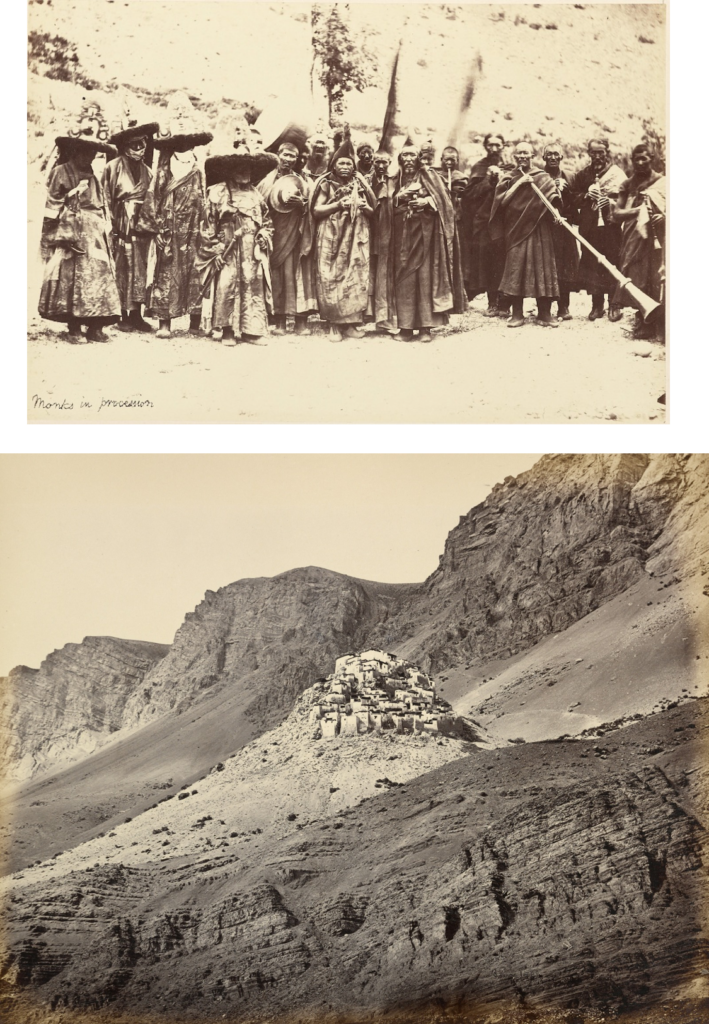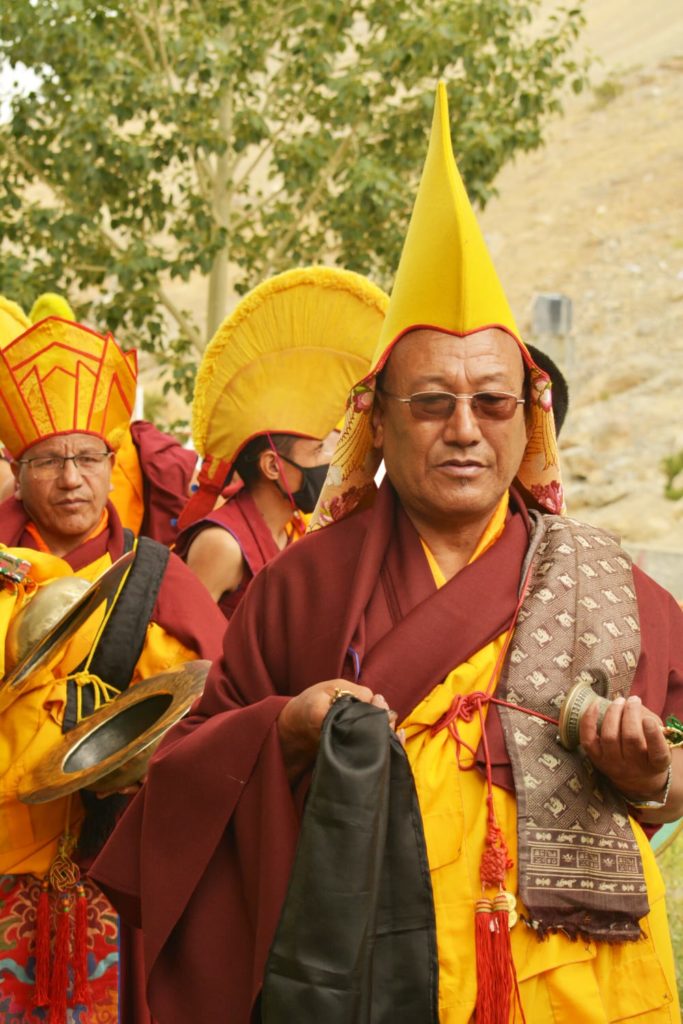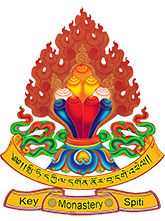Our Monastery
Key Gompa, also known as the ‘Monastery at the Center of the Mandala’, is the largest monastery in Spiti and holds great spiritual significance. It is home to the revered reincarnations of Lochen Rinchen Zangpo, also known as the ‘Great Translator’, who lived from 958 to 1055 AD. The monastery is strongly connected to the ancient Kadampa lineage and is considered the seat of the Lochen Tulkus lineage. Through this lineage, it is linked to the legendary 11th-century saint Srijnana Dipankara Atisha.
In the year 2000, His Holiness the 14th Dalai Lama dedicated a new, much larger assembly hall in Key Gompa. The hall is adorned with many old wall hangings, which beautifully depict events from the Buddha’s former lifetimes. Across from the main assembly hall, is a prayer room with a large prayer wheel and impressive statues of Padmasambhava and Amitayus.
The monastery is home to approximately 200 monks who receive a secular and religious education up to the tenth grade before going on to more advanced Buddhist teachings. The spiritual education bestowed here is held in the highest esteem, and it nurtures the monks’ souls to reach enlightenment and lead a life of spiritual fulfilment.


Our Monastery
Key Gompa, also known as the ‘Monastery at the Center of the Mandala’, is the largest monastery in Spiti and holds great spiritual significance. It is home to the revered reincarnations of Lochen Rinchen Zangpo, also known as the ‘Great Translator’, who lived from 958 to 1055 AD. The monastery is strongly connected to the ancient Kadampa lineage and is considered the seat of the Lochen Tulkus lineage. Through this lineage, it is linked to the legendary 11th-century saint Srijnana Dipankara Atisha.
In the year 2000, His Holiness the 14th Dalai Lama dedicated a new, much larger assembly hall in Key Gompa. The hall is adorned with many old wall hangings, which beautifully depict events from the Buddha’s former lifetimes. Across from the main assembly hall,is a prayer room with a large prayer wheel and impressive statues of Padmasambhava and Amitayus.
The monastery is home to approximately 200 monks who receive a secular and religious education up to the tenth grade before going on to more advanced Buddhist teachings. The spiritual education bestowed here is held in the highest esteem, and it nurtures the monks’ souls to reach enlightenment and lead a life of spiritual fulfillment.

Our History
Key Gompa is an ancient monastery located in Spiti that holds a significant place in the history of Tibetan Buddhism. The monastery was established in the early 15th century by Sherap Zangpo, a follower of Je Tsongkhapa, the founder of the Gelugpa sect. However, the monastery was subjected to various attacks and natural calamities over the centuries.
In the 17th century, Mongol armies invaded the monastery during the time of the 5th Dalai Lama, and it became part of the Gelugpa school of Tibetan Buddhism. The monastery was later sacked during the Ladakh-Kullu conflicts in 1820 and suffered heavy damage at the hands of the Dogra army in 1841. The Sikh forces also ravaged the monastery later that year. The monastery was destroyed by fire in the 1840s, and a major earthquake in 1975 caused further damage. The Archaeological Survey of India and the State Public Works Department reconstructed the monastery.
Despite its turbulent history, Key Monastery is known for its special wall hangings and other historical artefacts brought from Central Tibet by the line of Lochen incarnations. The topmost floor of the building houses an apartment for His Holiness, the Dalai Lama and a room that holds the remains of the 18th Lochen Tulku. A chapel with the monastery’s protector deities is located on the lower level. An assembly hall is situated on the floor beneath that and is used for rituals that do not necessitate the participation of the entire assembly. The remains of the 17th Lochen Tulku, valuable wall hangings, religious scriptures, and a statue of the future Buddha Maitreya are also housed in this room. Access the Protector chapel by descending an old set of stairs and passing through a short passage, which is used during the very cold winter months.
Key Gompa not only offers a glimpse into the history of Tibetan Buddhism but also boasts stunning architecture and a peaceful atmosphere.
Our Spiritual Director
The great Lotsawa Rinchen Zangpo (958-1055A.D.) was a renowned chief priest and Vajracharya of Tholing in the Guge Kingdom of Tibet. His remarkable translation skills earned him the title Lotsawa (translator), and he came to be known as Lotsawa Rinchen Zangpo. He played a significant role in the spread of Buddhism in Ladakh, Spiti, Kinnaur and Ngari regions in Tibet. He later became a disciple of the famous Indian Master Atishaa when he was in Tholing. Rinchen Zangpo is credited with constructing 108 gompas, including the Tabo Monastery, often referred to as the Ajantha of the Himalayas in Spiti. The Tabo Monastery is home to rare, frescos, and murals that are well preserved. Other notable monasteries he built include Lalung in Spiti, Alchi, located in Khalsi on the banks of the river Indus, Lamayuru Monastery, Wanla, Mangyu, and Sumda in Ladhak.
Legend has it that Rinchen Zangpo carried withered willow sticks with him to different sites in Ladakh, Zangskar, Spiti, Kinnaur, Bhutan, and Arunachal Pradesh while undertaking the divine task of building these monasteries overnight. He planted the sticks at various locations, and wherever they sprang to life and turned green, a monastery was constructed.
Today, the legacy of Rinchen Zangpo is carried on by the Reverend T.K. Lochen Tulku Rinpoche, the reincarnation of Rinchen Zangpo. He was born in the Kinnaur District of Himachal Pradesh in Northern India and is recognized as a master of Buddhist philosophy and Tantrayana Buddhism. Lochen Tulku Rinpoche received instruction from His Holiness the Dalai Lama, his two tutors, and the revered master, His Eminence Lati Rin, in both Sutra and Tantra.
As a respected teacher and leader, Lochen Tulku Rinpoche has tens of thousands of disciples and oversees monasteries across India’s Himalayan region. He is also a member of the Tashi Lhunpo Monastic University in Tibet and serves as the chair of several charitable organizations across India. Through his teachings and charitable works, he continues to uphold the rich spiritual and cultural heritage of the Himalayan region, following in the footsteps of the great Lotsawa Rinchen Zangpo.


Our Spiritual Director
The great Lotsawa Rinchen Zangpo (958-1055A.D.) was a renowned chief priest and Vajracharya of Tholing in the Guge Kingdom of Tibet. His remarkable translation skills earned him the title Lotsawa (translator), and he came to be known as Lotsawa Rinchen Zangpo. He played a significant role in the spread of Buddhism in Ladakh, Spiti, Kinnaur and Ngari regions in Tibet. He later became a disciple of the famous Indian Master Atishaa when he was in Tholing. Rinchen Zangpo is credited with constructing 108 gompas, including the Tabo Monastery, often referred to as the Ajantha of the Himalayas in Spiti. The Tabo Monastery is home to rare, frescos, and murals that are well preserved. Other notable monasteries he built include Lalung in Spiti, Alchi, located in Khalsi on the banks of the river Indus, Lamayuru Monastery, Wanla, Mangyu, and Sumda in Ladhak.
Legend has it that Rinchen Zangpo carried withered willow sticks with him to different sites in Ladakh, Zangskar, Spiti, Kinnaur, Bhutan, and Arunachal Pradesh while undertaking the divine task of building these monasteries overnight. He planted the sticks at various locations, and wherever they sprang to life and turned green, a monastery was constructed.
Today, the legacy of Rinchen Zangpo is carried on by the Reverend T.K. Lochen Tulku Rinpoche, the reincarnation of Rinchen Zangpo. He was born in the Kinnaur District of Himachal Pradesh in Northern India and is recognized as a master of Buddhist philosophy and Tantrayana Buddhism. Lochen Tulku Rinpoche received instruction from His Holiness the Dalai Lama, his two tutors, and the revered master, His Eminence Lati Rin, in both Sutra and Tantra.
As a respected teacher and leader, Lochen Tulku Rinpoche has tens of thousands of disciples and oversees monasteries across India’s Himalayan region. He is also a member of the Tashi Lhunpo Monastic University in Tibet and serves as the chair of several charitable organizations across India. Through his teachings and charitable works, he continues to uphold the rich spiritual and cultural heritage of the Himalayan region, following in the footsteps of the great Lotsawa Rinchen Zangpo.

Our Abbot
Khenpo (Abbot) Wangichuk Dorje is a highly accomplished and respected Buddhist master who has dedicated his life to the study and practice of Tibetan Buddhism. He was born in 1960 in Kiamo, a small village in the Spiti Tehsil of Himachal Pradesh, India. At the age of thirteen, he was ordained as a monk, and he spent the next seventeen years studying Buddhist philosophy and scripture.
Under the guidance of his Tantric Master Ringzin Dorje, Khenpo Wangichuk Dorje spent eighteen years studying and practising Tantric rituals. He also served as Umzat, the Chanting Master, and Konyer, the caretaker of the temple, at Key Monastery. He has received teachings from many renowned masters, including Lati Rinpoche, Drakyab Tokden Rinpoche, Lochen Tulku Rinpoche, and His Holiness the 14th Dalai Lama.
In recognition of his knowledge, dedication, and spiritual attainment, Khenpo Wangichuk Dorje was appointed as the Abbot of Key Monastery on 15 May 2022. As the new Abbot, he brings a wealth of experience and wisdom to the position and is committed to the preservation and propagation of the teachings of Tibetan Buddhism. His appointment is a great honour and a testament to his years of study, practice, and service to the monastery.
